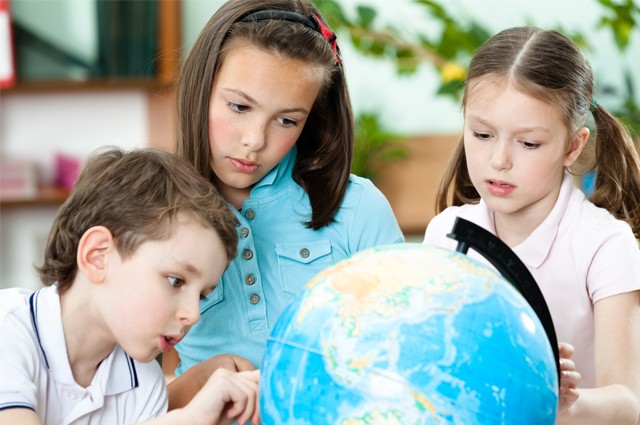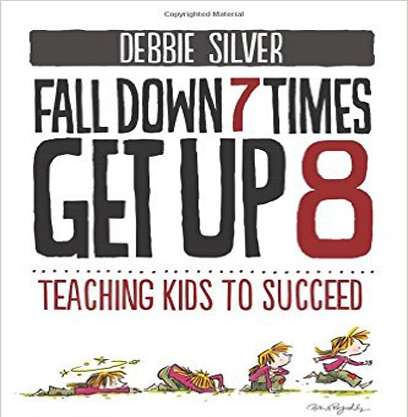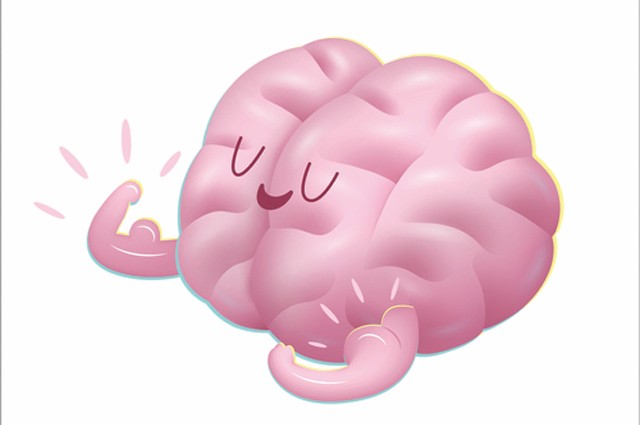In the last issue, I explored two child development and early learning milestones which provide an opportunity to nurture a growth mindset in early learners. In the following article I will explore two more: inquiry and school readiness.
III. Inquiry (Wonders and Questions)
As children interact with their environment, they are continuously engaged in inquiry, 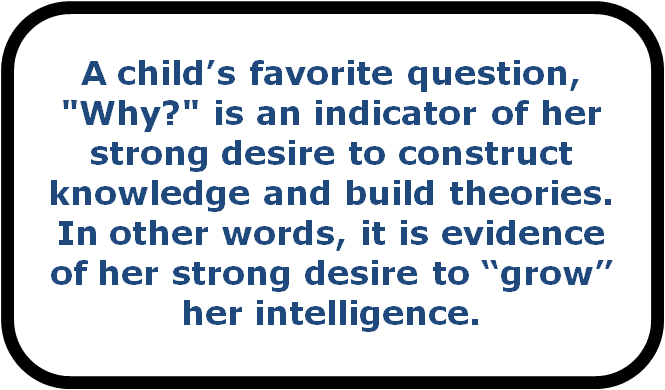 construction of knowledge, and theory building. The process of theory building itself is a very growth mindset oriented process in that it is "full of error, conflict, and contradiction" (Chaille, 2003). There is a natural connection between children as theory builders and children as having a growth mindset. A child's favorite question "Why?" is an indicator of their strong desire to construct knowledge and build theories. In other words, it is evidence of their strong desire to "grow" their knowledge and intelligence (GM).
construction of knowledge, and theory building. The process of theory building itself is a very growth mindset oriented process in that it is "full of error, conflict, and contradiction" (Chaille, 2003). There is a natural connection between children as theory builders and children as having a growth mindset. A child's favorite question "Why?" is an indicator of their strong desire to construct knowledge and build theories. In other words, it is evidence of their strong desire to "grow" their knowledge and intelligence (GM).
Within this GM opportunity, we can nurture a child's GM by (a) encouraging their wonder and questions and (b) facilitating opportunities for them to construct knowledge and build theories through the inquiry process:
1. Active observation and interaction with the environment (wonder)
2. Question asking
3. Investigation and experimentation
4. Development of conclusions
IV. School Readiness
The national and state focus on school readiness is an opportunity to connect and integrate growth mindset theory and practice with school readiness. A growth mindset supports the five school readiness domains: approaches to learning, social and emotional, cognitive, physical, and language and literacy. Specifically within the domains of approaches to learning and social and emotional learning, indicators of a growth mindset align with the domain elements of initiative and curiosity, persistence and attentiveness, cooperation, self-concept and self-efficacy, self-regulation, and social relationships. By nurturing a child's growth mindset, we are building their school readiness.
While understanding how the growth mindest looks across the developmental continuum helps to 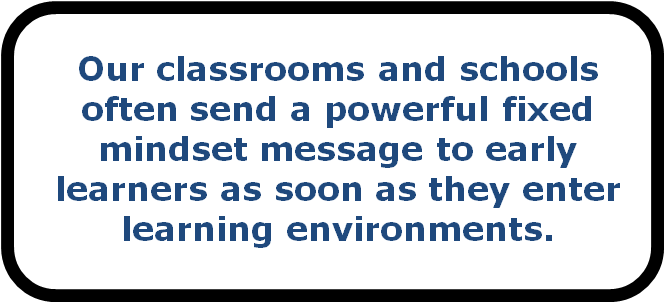 inform and guide how we nurture a gowth mindset in early learners, understanding what a fixed mindset message looks and sounds like is also important, especially considering the ubiquitous nature of fixed mindset messaging within our society. A fixed mindset message comes in a variety of forms: modeling, praise and feedback, the environment itself, social interactions, and within systemic structures.
inform and guide how we nurture a gowth mindset in early learners, understanding what a fixed mindset message looks and sounds like is also important, especially considering the ubiquitous nature of fixed mindset messaging within our society. A fixed mindset message comes in a variety of forms: modeling, praise and feedback, the environment itself, social interactions, and within systemic structures.
Parents, caregivers, and teachers can send a fixed mindset message through their words, choices, decisions, actions, and behaviors, ultimately oppressing a child's natural curiosity and intrinsic motivation to "grow." For example, when we provide unnecessary help or support to children on a given task or activity that they can otherwise do independently we are restricting their natural desire to develop and "grow." We are sending the message: "You can't do it yourself, you need my help". This message questions their sense of independence, self-efficacy, agency, and self-confidence. Other examples of a fixed mindset message include: intelligent-based praise and too much emphasis on the end result (the product, the grade, winning).
Within our classroom and school settings, a powerful fixed mindset message is often sent to early learners as soon as they enter learning environments which engage in traditional teaching practices and methods. It comes in the form of the "right answer" approach and the "one size fits all" approach. The "right answer" approach sends the message to early learners, "stop wondering and stop asking questions...I, as the teacher ask the questions and it is your job to find out what the 'right answer' is". The "one size fits all" approach sends the message that "your individual interests, inquiries, learning, and growth is not important." Ultimately, these fixed mindset messages contradict a child's natural curiosity and inquiry and desire to "grow" their knowledge and intelligence and thus their growth mindset.
Within our early learning communities we can nurture a growth mindset in early learners by (a) serving as growth mindset models and advocates (b) teaching them about the growth mindset, (c) actively observing them in their environment and providing appropriate growth mindset feedback and encouragement when a growth mindset child development and early learning opportunity (i.e. a challenge, a mistake, a problem, an opportunity to learn something new) presents itself, (d) nurturing their sense of independence, self-efficacy, and agency, and (e) encouraging their sense of wonder, inquiry, and theory building by engaging in practices consistent with constructivism (e.g. facilitating meaningful inquiry-based and collaborative learning opportunities).
Conclusion
Evidence of growth mindset oriented skills, tasks, and activities are ubiquitous in the early years, therefore we have an abundance of opportunities to nurture a growth mindset in early learners. We can nurture early learners from the earliest of stages by understanding and recognizing authentic growth mindset child development and early learning opportunities across the developmental continuum and engaging in growth mindset development practices.
References
Carter, Christine. (2010). Raising happiness. New York: Ballatine Books.
Chaille, Christine & Britain, Lory. (2003). The young child as scientist. Boston: Allyn and Bacon.
Dweck, Carol S. (2006). Mindset: The new psychology of success. New York: Random House.
Shelby, Paulina & Stanford, Christie. Preschoolers grow their brains: Shifting mindsets for greater resiliency and better problem solving. Young Children: September 2011.
School Readiness Indicators Initiative. (2005). Getting ready – School readiness indicators initiative: A 17 state partnership. Online: Getting Ready
About Kendra Coates
Kendra Coates is a mom to two early learners (4 and 2.5) and a PK-12 teacher/administrator. She currently serves as a P-3 Coordinator with the ESD working with districts to connect and integrate early learning and the K-12 system by transforming elementary schools from K-5 models to PreK-5 models. Within this work she is facilitating a PreK-3 pilot project called the PK-PhD Project via the University of Oregon's Doctorate of Education in Educational Methodology, Policy, and Leadership program. As part of the Project, she will be piloting a literacy-based Social and Emotional Learning curriculum based on the Growth Mindset which she developed with Mindset Works®. In addition, Kendra has earned a MAT in Special Education and a MS in Curriculum and Instruction with a specialization in literacy and ECE/ELEM education and serves on the Strategic Planning Committee/Advisory Board for an Oregon non-profit organization called Healthy Beginnings. You can contact Kendra at kendrajcoates@mindsetworks.com.
About Mindset Works
Mindset Works was co-founded by one of the world's leading researchers in the field of motivation, Stanford University professor Carol S. Dweck, Ph.D. and K-12 mindset expert Lisa S. Blackwell, Ph.D. The Company translates psychological research into practical products and services to help students and educators increase their motivation and achievement. For more information, visit http://www.mindsetworks.com.

